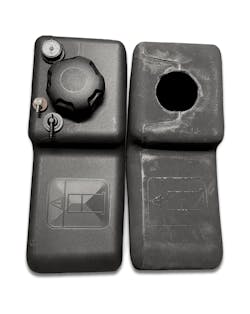Processor, material firm adapt resin to rotomold part with a challenging feature
By Bruce Geiselman
Problem: Rotomolded parts maker Gemstar Manufacturing needed a way to produce a fuel tank that could meet stringent EPA regulations for fuel vapor permeation.
Solution: The company partnered with Celanese, a global chemical and specialty materials company, and a distributor to develop a resin appropriate for the task.
Gemstar faced a difficult challenge when one of its clients, a groundskeeping equipment manufacturer, wanted Gemstar to design and manufacture a specialized fuel tank designed for groundskeeping equipment used on golf courses.
The equipment manufacturer wanted a fuel tank design that encompassed a difficult-to-mold funnel-type filler spout designed to prevent fuel overfills. In addition, the client wanted the lightweight tank to be manufactured from a single layer of plastic, and it had to meet U.S. Environmental Protection Agency (EPA) regulations for fuel vapor permeation.
But fuel tanks made with most plastics have difficulty meeting EPA fuel vapor standards. In particular, the EPA has environmental concerns regarding the production of fluorinated high-density polyethylene (HDPE) plastic containers.
Gemstar began using traditional rotomolding technology to manufacture the fuel tanks using nylon 6, which could meet the EPA’s fuel vapor permeation standards. However, nylon can be a challenging material to mold.
“Nylon 6 meets the EPA standards for permeation, which is a good part of nylon 6,” said Kevin Lumberg, channel manager for Gemstar. “The bad part of nylon 6, it’s very hard to mold. There is a very small manufacturing and processing window to get good parts. It doesn’t mold well around inserts. It doesn’t look very good, and you have lots of bubble issues around where the cap goes on it, and any of those bubble issues can cause a leakage of fuel.”
In addition, Gemstar found it impossible using nylon 6 to form the funnel-shaped feature of the filler neck desired by its customer.
At that point, Gemstar turned to a contract consultant to see if they had any suggestions. The consultant referred Gemstar to Dugan Bradfield, an account manager at Entec Polymers, saying he had a history of finding “out of the box” solutions. Entec Polymers came up with the idea of working with Celanese to formulate Hostaform polyoxymethylene (POM, aka acetal), which is routinely used in injection molding, into a powder form that could be rotomolded. The result was Hostaform POM RF.
According to Bradfield, compared to other polymers suitable for rotationally molded fuel tanks, Hostaform POM RF offers a number of advantages. It requires no mold release, and produces superior molded-in threads and molds better around inserts.
Bradfield and Chris Riggins, an Entec senior plastics engineer, flew out to Gemstar’s headquarters and worked with Gemstar engineers on developing a tool and process for manufacturing the fuel tanks using the newly formulated Hostaform POM RF and Gemstar equipment.
Gemstar’s proprietary robotic rotational molding system, called Robomold, was key to the process. Unlike traditional rotomolding, which uniformly heats a tool with oven heating, Gemstar's Robomold technology uses electricity to heat specific zones within the tool to different temperatures and at different times.
The technology is adapted — with an Americanized spelling — from technologies from AMS Robotics, Bilzen, Belgium, where the precursor system is called Robomould. After importing a Robomould system, Gemstar customized and improved it, transforming it into the company’s own system.
The manufacturing process is fully automated and involves a six-axis robot. That level of precision and repeatability was essential to consistently form the funnel design on the fuel tank fill area. The funnel area needed different heating times because the plastic was considerably thinner, only about 1/16 of an inch, than the thick fuel tank walls.
“This tank that we’re doing for our customer with the robot and with Hostaform probably couldn’t be done conventionally,” Lumberg said. “We started with a problem that had no solution and pretty much researched and developed an entire solution with the Robomold technology and Hostaform.”
The improvement in part quality and consistency has been significant.
“With nylon 6, we had a very high scrap rate to get good tanks,” Lumberg said. “Many bad tanks had to be thrown away. With Hostaform, we brought that scrap rate down to a minimum. Sometimes, we aren’t getting any scrap on these runs. It’s a huge win as well from being able to cost-effectively produce these tanks.”
Reducing the scrap rate can result in significant cost savings. The manufacturing change has also improved the appearance of the product.
“The nylon 6 tank just cosmetically doesn’t look very nice,” Lumberg said. “But the new tank out of Hostaform, it’s got a very nice, clean cosmetic look that looks a lot closer to polyethylene. The company’s logo is on this tank, so it’s very important to have a good-looking finished product.”
The precise process allows for optimization of material and reduction of processing time by up to 50 percent compared to the industry average, according to Gemstar. These tanks can accommodate a nearly endless array of fuel types and the streamlined design is formulated through a single-layer solution, contrary to other options on the market.
Contact information:
Gemstar Manufacturing, Cannon Falls, Minn., 800-533-3631, www.gemstarmfg.com
About the Author
Bruce Geiselman
Senior Staff Reporter Bruce Geiselman covers extrusion, blow molding, additive manufacturing, automation and end markets including automotive and packaging. He also writes features, including In Other Words and Problem Solved, for Plastics Machinery & Manufacturing, Plastics Recycling and The Journal of Blow Molding. He has extensive experience in daily and magazine journalism.
